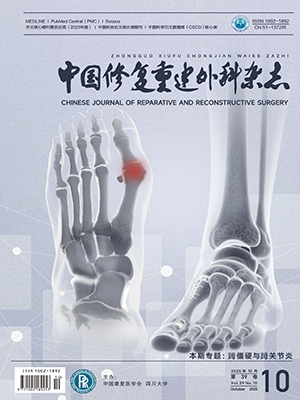| 1. |
Scaglioni MF, Rittirsch D, Giovanoli P. Reconstruction of the heel, middle foot sole, and plantar forefoot with the medial plantar artery perforator flap: Clinical experience with 28 cases. Plast Reconstr Surg, 2018, 141(1): 200-208.
|
| 2. |
Lohasammakul S, Turbpaiboon C, Chaiyasate K, et al. Anatomy of medial plantar superficial branch artery perforators: Facilitation of medial plantar superficial branch artery perforator (MPAP) flap harvesting and design for finger pulp reconstruction. Microsurgery, 2018, 38(5): 536-543.
|
| 3. |
曾昂, 乔群, 方柏荣, 等. 增强CT 辅助设计带蒂腹壁下动脉穿支皮瓣的临床应用. 中国修复重建外科杂志, 2008, 22(12): 1426-1429.
|
| 4. |
Zheng Y, Zhang S, Hong JP, et al. Medial plantar artery perforator kiss flap for salvage of extensive palmar skin defect. Plast Reconstr Surg, 2024, 153(6): 1348-1357.
|
| 5. |
Liu JF, Zhao LR, Lu LJ, et al. Limb salvage surgery following resection of a melanoma: Foot and ankle reconstruction using cutaneous flaps. Oncol Lett, 2014, 8(5): 1966-1972.
|
| 6. |
Suh YC, Suh HP, Lee JS, et al. Reconstruction using a perforator free flap after malignant melanoma resection of the ankle and foot. J Surg Oncol, 2017, 116(7): 862-869.
|
| 7. |
Bae YC, Kim JH, Yi CC. The value of anterolateral thigh free flap for the reconstruction of malignant melanoma of the sole of the foot. Ann Plast Surg, 2024, 92(4): 424-431.
|
| 8. |
Lee KT, Park SJ, Mun GH. Reconstruction outcomes of oncologic foot defect using well-contoured free perforator flaps. Ann Surg Oncol, 2017, 24(8): 2404-2412.
|
| 9. |
Suh YC, Kim HB, Brown E, et al. Maximizing the flap inflow in a foot reconstruction: Ultrasonographic evaluation of artery flow in accordance with the angle of the ankle. Plast Reconstr Surg, 2021, 148(2): 258e-261e.
|
| 10. |
Shah KD, Zhou J, Roper J, et al. Photon-counting CT in cancer radiotherapy: technological advances and clinical benefits. Phys Med Biol, 2025, 70(10): 10TR01. doi: 10.1088/1361-6560/add4ba.
|
| 11. |
Flores JD, Poludniowski G, Szum A, et al. Clinical photon-counting CT increases CT number precision and reduces patient size dependence compared to single- and dual-energy CT. Br J Radiol, 2025, 98(1169): 721-733.
|
| 12. |
Watanabe M, Murakami R, Miyauchi R, et al. Utility of preoperative multidetector-row computed tomographic angiography after sublingual nitroglycerin with three-dimensional reconstruction in planning of the anterolateral thigh flap. Plast Reconstr Surg, 2020, 145(2): 407e-411e.
|
| 13. |
Ahmad Alwi AA, Low CL, Kow RY, et al. Evaluation of feasibility of medial plantar artery flap with computed tomography angiography in diabetic patients: A pilot radioanatomic study. Cureus, 2023, 15(10): e48067. doi: 10.7759/cureus.48067.
|
| 14. |
裴广楠, 李甲, 滕道练, 等. 重建感觉的游离足底内侧动脉穿支皮瓣修复指端创面的效果分析. 中华显微外科杂志, 2022, 45(5): 534-5385.
|
| 15. |
王克彬, 尹国瑞, 刘凯, 等. 游离足底内侧皮瓣修复手部掌侧软组织缺损17例. 中华显微外科杂志, 2024, 47(3): 321-324.
|
| 16. |
Dhamangaonkar AC, Patankar HS. Reverse sural fasciocutaneous flap with a cutaneous pedicle to cover distal lower limb soft tissue defects: experience of 109 clinical cases. J Orthop Traumatol, 2014, 15(3): 225-229.
|
| 17. |
Wang M, Xu Y, Wang J, et al. Surgical management of plantar melanoma: A retrospective study in one center. J Foot Ankle Surg, 2018, 57(4): 689-693.
|




